Author: Grayscale Research Translation: Shan Ouba, Golden Finance
Bitcoin fully recovered from the 2021-22 decline and reached an all-time high in March 2024 . Grayscale Research believes central banks' rush to cut interest rates could be a factor driving demand for alternative stores of value like physical gold and Bitcoin.
Ethereum successfully implemented a major network upgrade, but the Ethereum (ETH) token performed below Bitcoin, this may be becausethe likelihood of spot ETF approval in the US market is considered lower.
The upcoming Bitcoin halving (scheduled for April 19) will make the issuance of Bitcoin halved in volume,which would contrast the predictable monetary policy of the Bitcoin network with the uncertain future of fiat currencies.
Bitcoin has once again rebounded strongly after experiencing a sharp decline. During the most recent cryptocurrency cycle, Bitcoin’s price peaked at $69,000 in November 2021. It then fell about 75% over the next year, bottoming out at about $16,000 in November 2022 before starting to recover. [1] Overall, it took just over two years for Bitcoin prices to return to their previous peaks (Chart 1). By comparison, it took about three years to recover from the first two declines, and about a year and a half to recover from the first major decline. Grayscale Research believes that We are now in the "mid-term" of another Bitcoin bull market, when prices may continue to climb (For more information, see Grayscale: Where are we in the bull market? What are the two key drivers?").
Chart 1: Bitcoin recovers faster than the previous two cycles
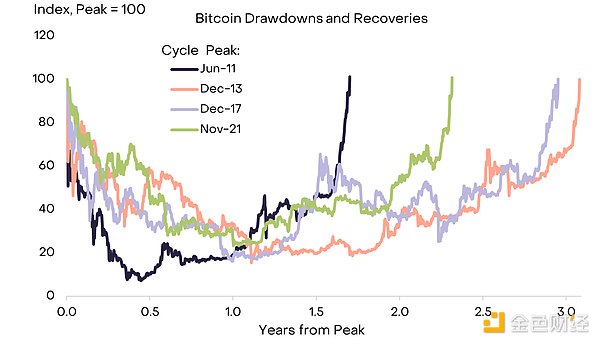
Except In addition to Bitcoin and Ethereum, many traditional assets also achieved positive returns in March 2024. On a risk-adjusted basis (i.e., taking into account each asset’s volatility), Bitcoin’s performance is at the upper end of the spectrum, while Ethereum’s gains are closer to the middle (Chart 2).
The best-performing traditional asset classes last month included physical gold, non-U.S. developed market stocks and energy-related stocks. Certain stock sectors related to emerging technologies, such as biotechnology, have underperformed the broader market.
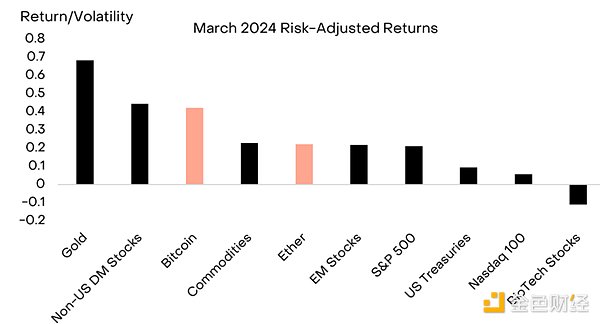
p>
Note: The vertical axis shows the percentage change from the end of February to the end of March, divided by 360 days of volatility. Data source: Bloomberg, Grayscale Investments. Ends March 31, 2024. Past performance is not indicative of future results. Indexes include S&P 500 Index, Nasdaq 100 Index, Morgan Stanley Emerging Markets Index (local FX), Morgan Stanley Global ex-U.S. Index (local FX), S&P/GSCI, Bloomberg-Barclays U.S. Treasury Index , S&P Biotechnology Select Industry Index. These indices are non-custodial investments and you cannot invest directly in the index itself.
Figure 2: Bitcoin is one of the best-performing assets in March 2024 1
One of the reasons for the overall strong market performance last month may have been signals from majorcentral banks that interest rates are about to be cut strong>. A survey conducted by Bloomberg showed that all G10 central banks except the Bank of Japan are expected to cut policy rates in the coming year. [2] Events over the past month have reinforced this expectation. For example, Fed officials said at their March 19-20 meeting that they still plan to cut interest rates three times this year despite forecasts of stronger GDP growth and higher inflation. Similarly, no Bank of England official advocated a rate hike for the first time since September 2021, and the Swiss National Bank unexpectedly cut its policy rate on March 21. [3]
Major central banks are eager to cut interest rates despite strong economic growth, which may lead to an increase in market inflation expectations. For example, the spread between nominal U.S. Treasuries and inflation-protected Treasury securities (i.e., “breakeven inflation”) has increased across all maturities this year (Chart 3). The risk of rising inflation could spur demand for alternative stores of value, such as physical gold and Bitcoin.
Chart 3: Market inflation expectations rise

* Difference between nominal and inflation-linked U.S. Treasuries ("Inflation Expectations" %: Based on the Fed's PCE inflation target of 2%, adjusted for Consumer Price Index inflation conditions. Source: Bloomberg, Grayscale Investments. Data as of March 31, 2024: Past performance is not indicative of future results: For illustrative purposes only.
While Bitcoin hits new all-time highs , but it also experienced a correction of about 13% in the middle of the month as traders lightened their positions and inflows into U.S.-listed spot Bitcoin ETFs slowed. [4] Throughout March, net inflows into U.S.-listed spot Bitcoin ETFs totaled 4.6 billion US dollars, down from US$6 billion in February. [5] Net inflows into spot Bitcoin ETFs, while lower than last month, are still much higher than the Bitcoin network’s issuance. According to our estimates, in Bitcoin terms, These U.S. ETFs purchased approximately 2,100 Bitcoins per day in March, while network issuance was approximately 900 per day during the same period (Chart 4). [6] After the halving in April, network issuance will drop to approximately 450 per day.
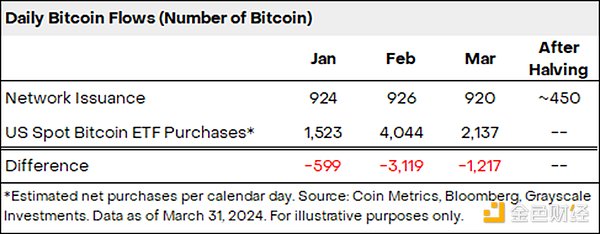
Figure 4: ETF inflows continue to exceed network issuance
Meanwhile, the Ethereum network conducted a A major upgrade designed to reduce the cost of Layer 2 (L2) chains and facilitate Ethereum’s transition to a modular architecture (see Ethereum’s Rites of Passage: “Dencun” and ETH 2.0 for details). This upgrade The impact can already be observed on-chain: transaction fees on L2s such as Arbitrum and Optimism dropped from $0.21 and $0.23 respectively in February to less than $0.01 after the upgrade, allowing end users to conduct transactions in the Ethereum ecosystem Transaction costs are lower.
Although the upgrade may have been priced in by the market beforehand, Ethereum (ETH) underperformed Bitcoin (BTC) during the month, with the ETH/BTC price ratio falling to the lowest level since early January (Chart 5). Declining expectations for spot ETF approval in the US market may have dampened ETH valuations. According to decentralized forecasting platform Polymarket, market consensus expects the likelihood of the U.S. Securities and Exchange Commission (SEC) approving a spot ETH ETF to fall to 21% from about 80% in January. We expect the prospect of approval or rejection of spot ETH ETFs in the current wave of applications will be a significant driver of the token’s valuation over the next two months.
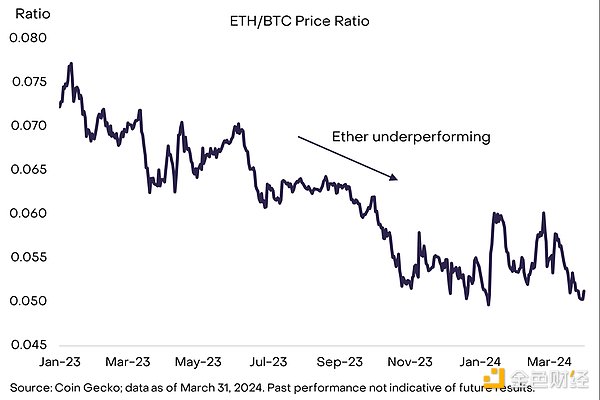
Exhibit 5: Despite major network upgrades Ethereum still lags behind Bitcoin
Grayscale has developed the concept of Grayscale Crypto Sectors, which is A comprehensive framework that divides the crypto asset class into five distinct sub-sectors that investors can use to track activity in the crypto space beyond Bitcoin and Ethereum. From a crypto sub-sector perspective, the best-performing segment in March was “Consumption & Culture,” reflecting high returns from “meme coins” (Exhibit 6). [8] Memecoins reflect Internet culture. In the crypto space, memecoin-related tokens are mainly traded for entertainment purposes; these projects have historically neither generated revenue nor tangible use cases (such as payments). Therefore should be considered a very high risk investment. That being said, the developers of Shiba Inu (the second largest meme coin in the consumer & cultural crypto sub-sector by market cap) are trying to expand the scope of the project by launching an Ethereum L2 that L2 runs decentralized finance (DeFi) activities. [9]
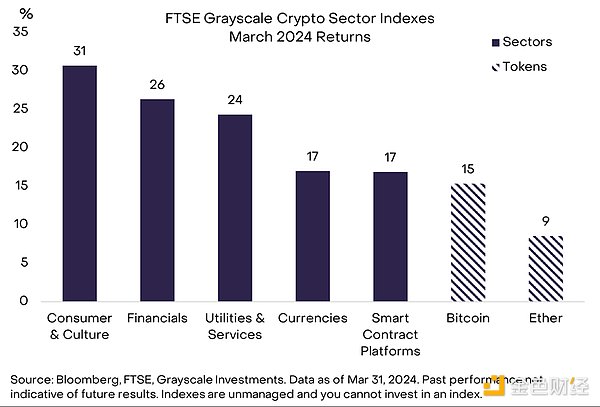
< p style="text-align: left;">Exhibit 6: Consumer and cultural crypto sectors grow over 30%
Some of the "financial" crypto sub-sectors Tokens also posted solid returns during the month, with top performers including Binance Coin (BNB), MakerDao Governance Token (MKR), THORChain (RUNE), 0x (ZRX), and Ribbon Finance (RBN). Binance’s share of spot trading volume has started to recover in recent months (it currently stands at 46%), but is still below the peak reached in February 2023. [10] THORchain is a decentralized exchange that allows native cross-chain swaps to exchange tokens across blockchains, such as from Bitcoin to Ethereum, and potentially benefit from broader Bitcoin ecosystem growth.
Like all other asset markets, cryptocurrency valuations are influenced by both fundamental and technical factors. From a technical perspective, net inflows/outflows from U.S.-listed spot Bitcoin ETFs are likely to continue to be a significant driver of Bitcoin prices in the near term. These products currently hold approximately 4% of the circulating Bitcoin supply, so any small change in demand could create significant Bitcoin flows. [11]
However, we believe that investor demand for Bitcoin ultimately stems in part from their optimism in its properties as a "store of value" asset. Bitcoin is an alternative currency system with a unique and highly predictable monetary policy. The supply of dollars is determined by those at the U.S. Treasury and Federal Reserve Boards, while the supply of Bitcoin is determined by pre-existing code: every four years, the daily issuance is cut in half until a total cap of 21 million coins is reached.
Grayscale Research believes that when investors are uncertain about the medium-term prospects of fiat currencies, they will seek assets with this kind of verifiable scarcity. Currently, this uncertainty appears to be rising: the Fed is preparing to cut interest rates even though inflation remains above its target, while the U.S. elections in November may spur macro policy changes that could lower the dollar's value over time. value. Next month’s Bitcoin halving event should remind investors of Bitcoin’s fundamental nature as a scarce digital asset and a substitute for fiat currencies, the future supply of which is uncertain.
[1] Source: CoinMetrics.
[2] Monthly Bloomberg surveys of economists/forecasters; data from Bloomberg Terminal as of March 31, 2024.
[3] Source: “Bank of England Inches Closer to Rate Cuts as Hawks Retreat", Bloomberg, March 21, 2024; "SNB First to Loosen as Swiss Franc Strength Tops Concerns", Bloomberg, March 21, 2024.
[ 4] Source: Bloomberg; based on New York closing prices from March 13 to March 19.
[5] Source: Bloomberg, as of March 28, 2024.
[6] Source: Grayscale Research calculations based on Bloomberg data, as of March 31, 2024.
[7] L2Fees
[8] The FTSE Grayscale Crypto Sectors family of indexes underwent its regular quarterly rebalancing on Sunday, March 17.
[9] Source: CoinDesk
[10] Source: The Block.
[11] Source: Bloomberg, data as of March 28, 2024.
 JinseFinance
JinseFinance















